Abstract
At the same time that carcinogenicity of very thin glass fibers after intrapleural and intraperitoneal (ip) administration was demonstrated (1,2) researchers found that gypsum fibers and HCI-leached chrysotile fibers were easily soluble in the peritoneal cavity. This led to the conclusion that the chemical composition of fibers was not responsible for the carcinogenesis but that the degree of carcinogenic potency of a fiber depended on the extent to which it retained its fibrous structure. A thin glass fiber with a low biodurability did not induce tumors after ip injection of a high dose, although the ip test had been criticized for being "overly sensitive." The ip model has been the most successful for determining carcinogenicity of inorganic fibers and establishing dose-response relationships; but to determine the possibilities and limitations of this test model, very high doses of nonfibrous silicon carbide and of a slightly durable glass fiber type were injected ip in Wistar rats. No obviously acute or chronic toxic effect was observed in 90 weeks, but there was a 40% incidence of serosal tumors in the group treated with glass fibers. A pilot study on the persistence of slag fibers in the omentum of rats after ip injection showed a half-time of about 1 year. It was calculated that an ip injection of 10(9) fibers would lead to a concentration of fiber numbers in the ash of the omentum in the same range as the concentration in the lung after 2 years of inhalation exposure. The long-term inhalation study with fibers in rats has been called the "gold standard" for risk characterization.(ABSTRACT TRUNCATED AT 250 WORDS)
Full text
PDF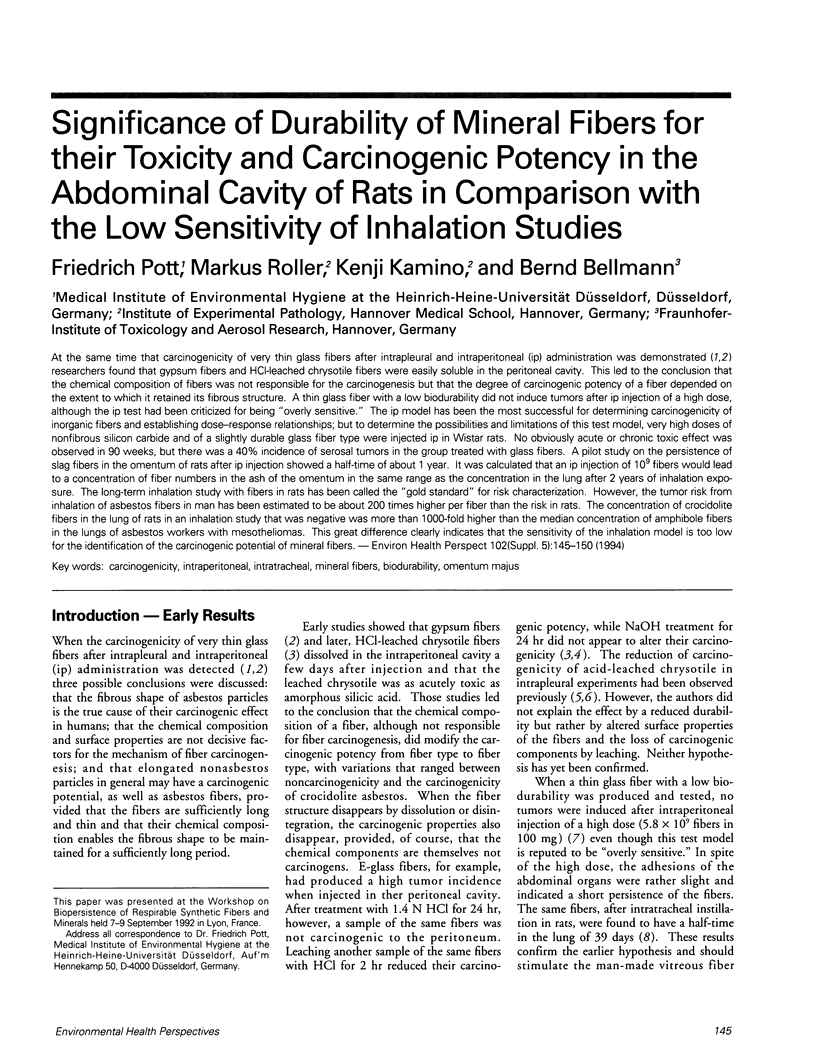
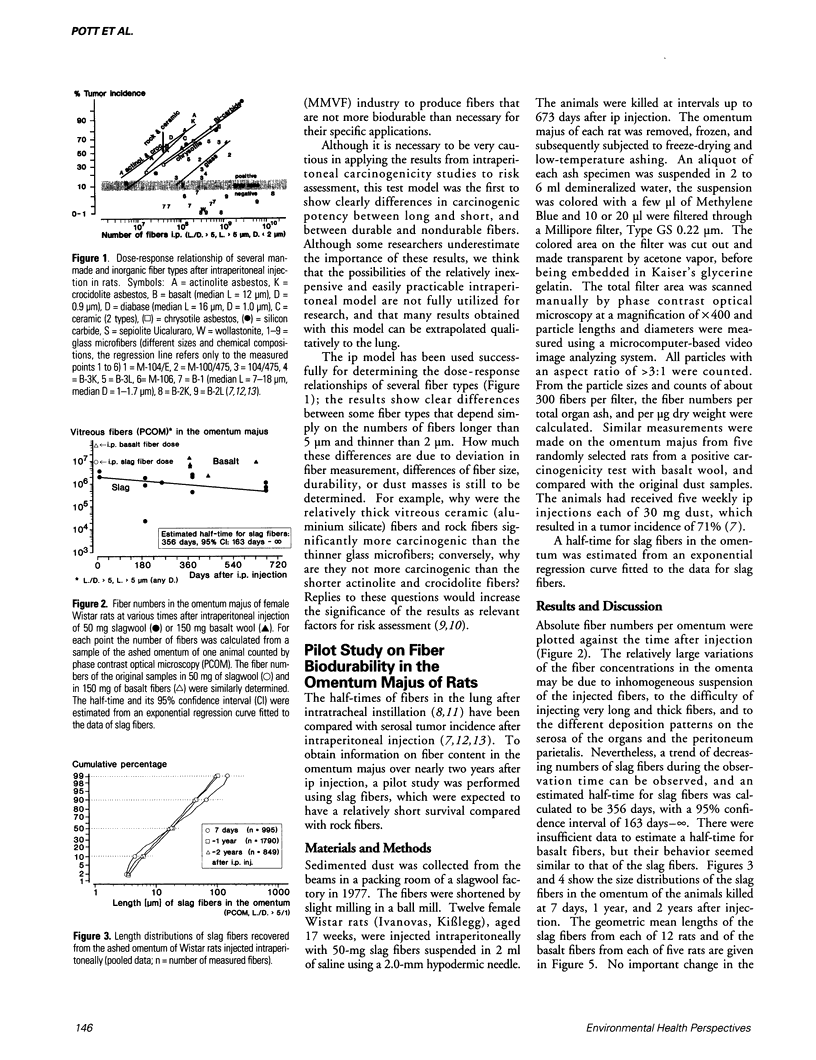
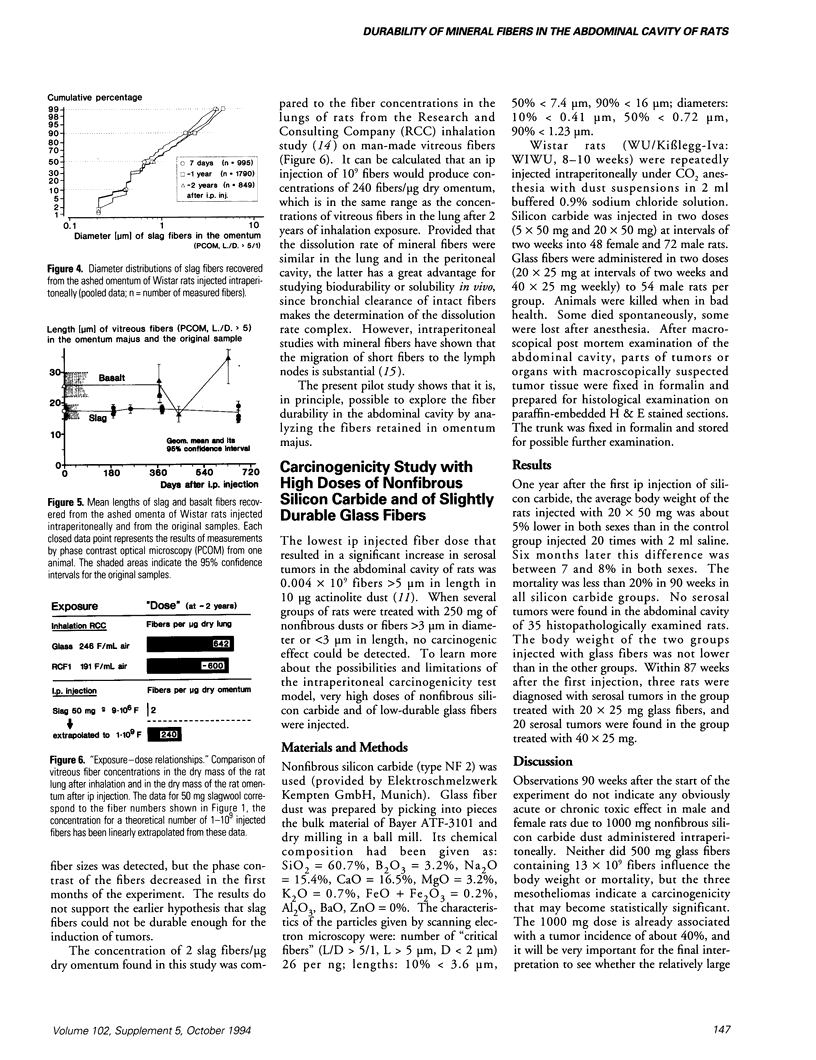
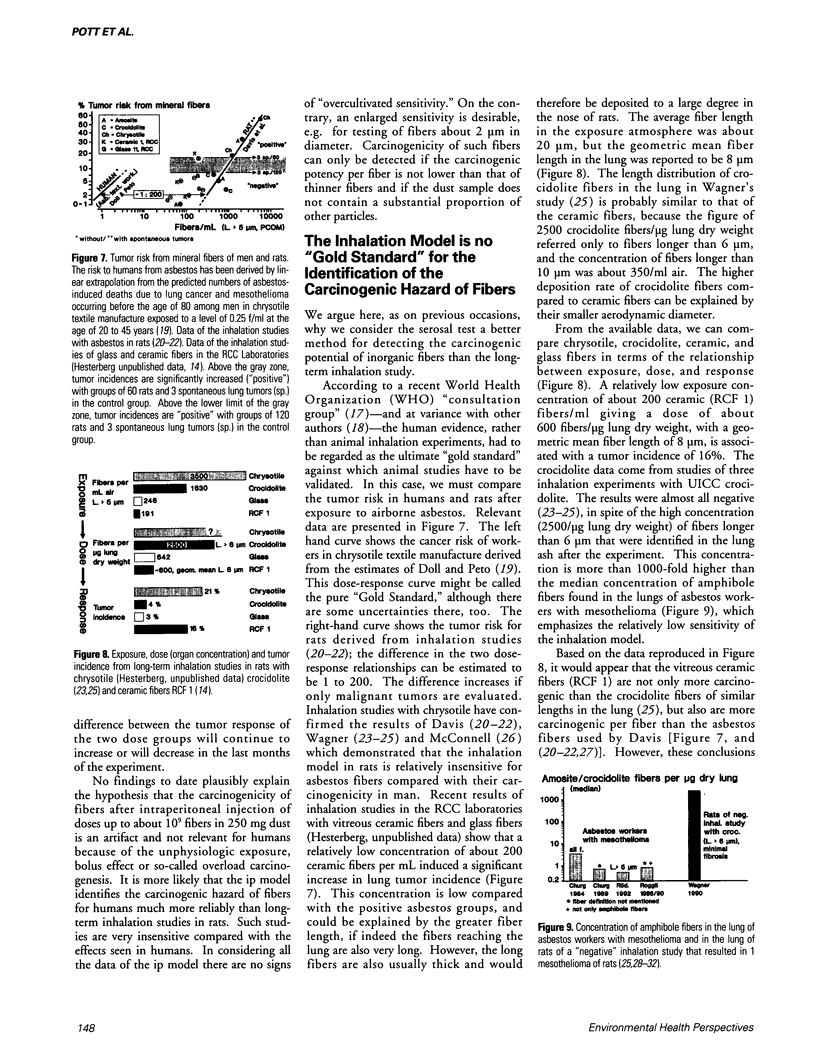
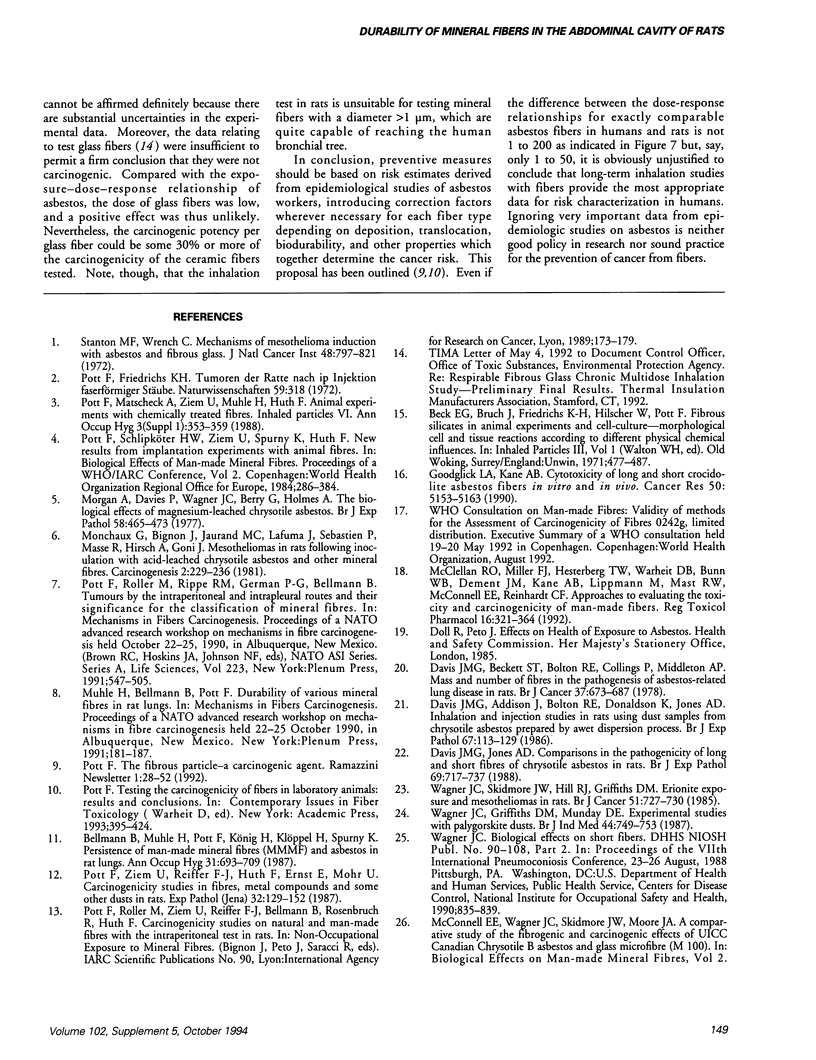
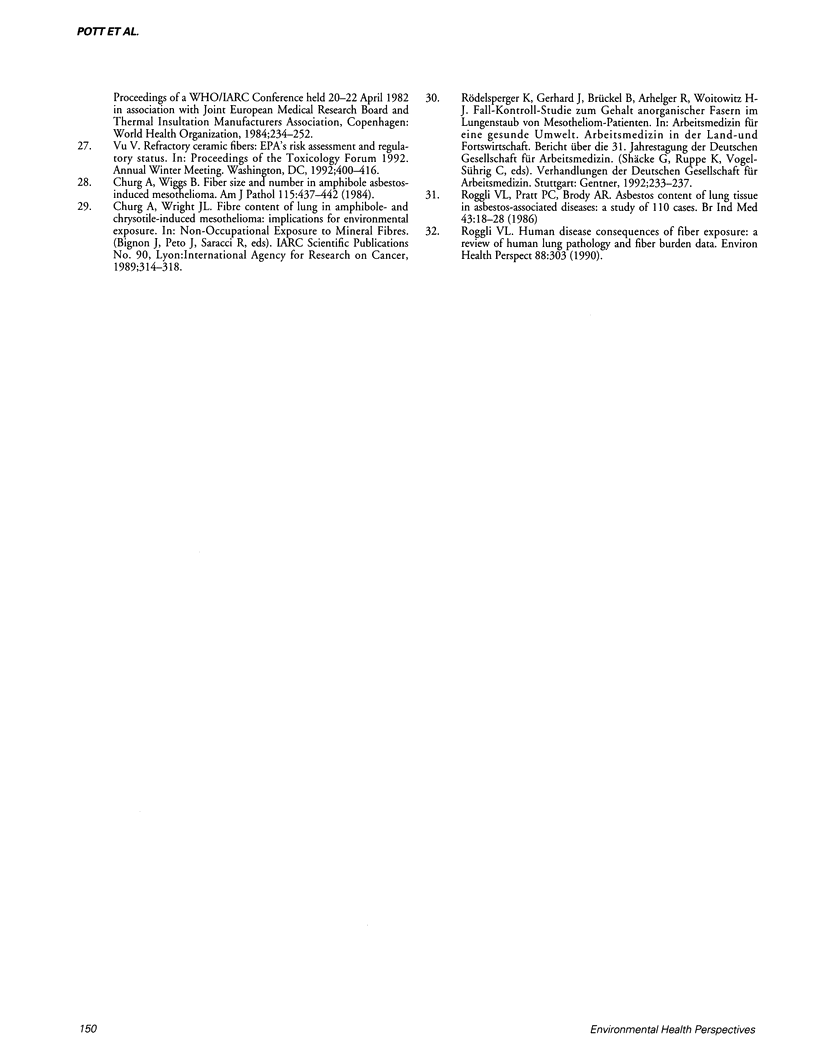
Selected References
These references are in PubMed. This may not be the complete list of references from this article.
- Beck E. G., Bruch J., Friedrichs K. H., Hilscher W., Pott F. Fibrous silicates in animal experiments and cell-culture-morphological cell and tissue reactions according to different physical chemical influences. Inhaled Part. 1970;1:477–487. [PubMed] [Google Scholar]
- Bellmann B., Muhle H., Pott F., König H., Klöppel H., Spurny K. Persistence of man-made mineral fibres (MMMF) and asbestos in rat lungs. Ann Occup Hyg. 1987;31(4B):693–709. doi: 10.1093/annhyg/31.4b.693. [DOI] [PubMed] [Google Scholar]
- Churg A., Wiggs B. Fiber size and number in amphibole asbestos-induced mesothelioma. Am J Pathol. 1984 Jun;115(3):437–442. [PMC free article] [PubMed] [Google Scholar]
- Churg A., Wright J. L. Fibre content of lung in amphibole- and chrysotile-induced mesothelioma: implications for environmental exposure. IARC Sci Publ. 1989;(90):314–318. [PubMed] [Google Scholar]
- Davis J. M., Addison J., Bolton R. E., Donaldson K., Jones A. D. Inhalation and injection studies in rats using dust samples from chrysotile asbestos prepared by a wet dispersion process. Br J Exp Pathol. 1986 Feb;67(1):113–129. [PMC free article] [PubMed] [Google Scholar]
- Davis J. M., Beckett S. T., Bolton R. E., Collings P., Middleton A. P. Mass and number of fibres in the pathogenesis of asbestos-related lung disease in rats. Br J Cancer. 1978 May;37(5):673–688. doi: 10.1038/bjc.1978.105. [DOI] [PMC free article] [PubMed] [Google Scholar]
- Davis J. M., Jones A. D. Comparisons of the pathogenicity of long and short fibres of chrysotile asbestos in rats. Br J Exp Pathol. 1988 Oct;69(5):717–737. [PMC free article] [PubMed] [Google Scholar]
- Goodglick L. A., Kane A. B. Cytotoxicity of long and short crocidolite asbestos fibers in vitro and in vivo. Cancer Res. 1990 Aug 15;50(16):5153–5163. [PubMed] [Google Scholar]
- McClellan R. O., Miller F. J., Hesterberg T. W., Warheit D. B., Bunn W. B., Kane A. B., Lippmann M., Mast R. W., McConnell E. E., Reinhardt C. F. Approaches to evaluating the toxicity and carcinogenicity of man-made fibers: summary of a workshop held November 11-13, 1991, Durham, North Carolina. Regul Toxicol Pharmacol. 1992 Dec;16(3):321–364. doi: 10.1016/0273-2300(92)90011-w. [DOI] [PubMed] [Google Scholar]
- Monchaux G., Bignon J., Jaurand M. C., Lafuma J., Sebastien P., Masse R., Hirsch A., Goni J. Mesotheliomas in rats following inoculation with acid-leached chrysotile asbestos and other mineral fibres. Carcinogenesis. 1981;2(3):229–236. doi: 10.1093/carcin/2.3.229. [DOI] [PubMed] [Google Scholar]
- Morgan A., Davies P., Wagner J. C., Berry G., Holmes A. The biological effects of magnesium-leached chrysotile asbestos. Br J Exp Pathol. 1977 Oct;58(5):465–473. [PMC free article] [PubMed] [Google Scholar]
- Pott F., Friedrichs K. H. Tumoren der Ratte nach i.p.-Injektion faserförmiger Stäube. Naturwissenschaften. 1972 Jul;59(7):318–318. doi: 10.1007/BF00593370. [DOI] [PubMed] [Google Scholar]
- Pott F., Ziem U., Reiffer F. J., Huth F., Ernst H., Mohr U. Carcinogenicity studies on fibres, metal compounds, and some other dusts in rats. Exp Pathol. 1987;32(3):129–152. doi: 10.1016/s0232-1513(87)80044-0. [DOI] [PubMed] [Google Scholar]
- Roggli V. L. Human disease consequences of fiber exposures: a review of human lung pathology and fiber burden data. Environ Health Perspect. 1990 Aug;88:295–303. doi: 10.1289/ehp.9088295. [DOI] [PMC free article] [PubMed] [Google Scholar]
- Roggli V. L., Pratt P. C., Brody A. R. Asbestos content of lung tissue in asbestos associated diseases: a study of 110 cases. Br J Ind Med. 1986 Jan;43(1):18–28. doi: 10.1136/oem.43.1.18. [DOI] [PMC free article] [PubMed] [Google Scholar]
- Stanton M. F., Wrench C. Mechanisms of mesothelioma induction with asbestos and fibrous glass. J Natl Cancer Inst. 1972 Mar;48(3):797–821. [PubMed] [Google Scholar]
- Wagner J. C., Griffiths D. M., Munday D. E. Experimental studies with palygorskite dusts. Br J Ind Med. 1987 Nov;44(11):749–763. doi: 10.1136/oem.44.11.749. [DOI] [PMC free article] [PubMed] [Google Scholar]
- Wagner J. C., Skidmore J. W., Hill R. J., Griffiths D. M. Erionite exposure and mesotheliomas in rats. Br J Cancer. 1985 May;51(5):727–730. doi: 10.1038/bjc.1985.108. [DOI] [PMC free article] [PubMed] [Google Scholar]


